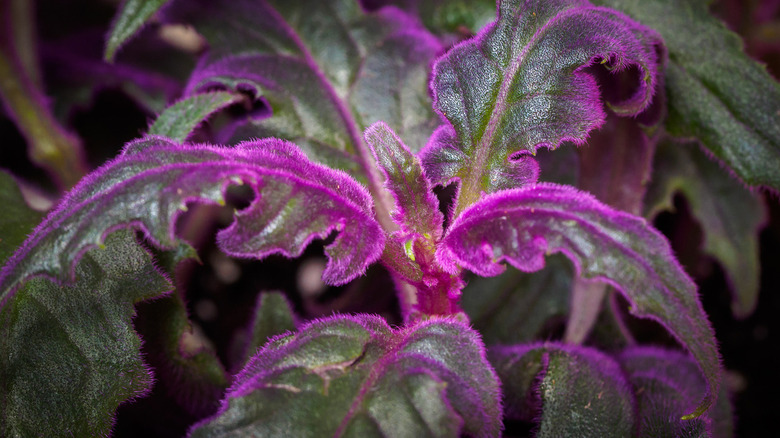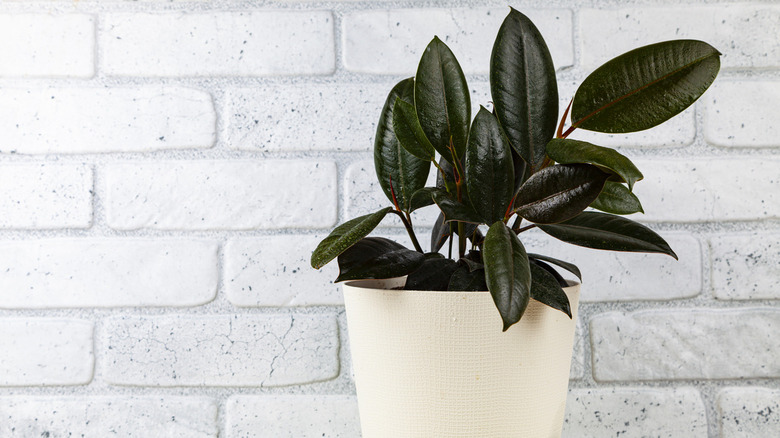15 Plants With Purple Leaves Perfect For Your Indoor Space
Are you interested in giving the interior of your home a facelift? Well, consider adding a few impressive houseplants with the right colors to match. You might not know this, but including houseplants as part of your interior decor might save you a lot of money compared to a major renovation project.
The world of indoor plants includes a lot of variety, and as a result, it can be quite overwhelming to pick the right one. The fact that indoor plants also come in plenty of color options doesn't make the process any easier.
However, there are a few plant colors that will give your indoor space that wow factor, and purple happens to be one of them. There is something special about the color purple; it's associated with royalty, extravagance, and ambition, not to mention it also has a calming and uplifting effect on the mind and body (via Bourn Creative). So if you are looking for a plant with purple leaves to revitalize your indoor space, here are 15 options that should help you get started.
1. Purple oxalis
The purple oxalis (Oxalis triangularis) is a rather uncommon plant with dark purple leaves. This plant has unique triangular leaves that grow in groups of three. Although it's often grown in the garden, the purple oxalis can be potted and grown indoors to add color to your home's interior. According to Michigan State University Extension, the purple oxalis is ideal for the south-facing windows because they take direct sunlight better indoors.
Bloom Season: Spring, summer, winter
USDA Growing Zone: 8-10
Growing Conditions: Full sun, partial shade
Soil Type: Well-drained soil
Size: 6-12 inches tall, 1-2 feet wide
2. Prayer plant
The prayer plant (Maranta leuconeura) is an indoor plant that's grown exclusively for its beautiful foliage. The most common variety is the tricolor option with a careful combination of purple, brown, and a touch of yellow along the midrib. However, if you decide to settle for this plant, the New York Botanical Garden advises you should protect it from direct sunlight lest you lose its vibrant leaves.
Bloom Season: Spring
USDA Growing Zone: 11-12
Growing Conditions: Full to partial shade
Soil Type: Moist well-drained soil
Size: 6-12 inches tall, 6-12 inches wide
3. Coleus
Coleus (Plectranthus scutellarioides) is one of the most popular houseplants thanks to its versatility. This indoor plant occurs in almost any color, including purple, not to mention it can also be grown in the garden as well. They don't require a lot of maintenance; an adequate amount of filtered light and water should do it (via the University of Minnesota Extension).
Bloom Season: Seasonal
USDA Growing Zone: 10-11
Growing Conditions: Filtered sunlight
Soil Type: Rich well-drained soil
Size: 6-36 inches tall, 6-36 inches wide
4. Wandering jew
If you're looking for a fast-growing plant with impressive purple leaves, look no further than the wandering Jew (Tradescantia zebrina). Although often considered invasive or a garden weed, the best way of taming this plant is to take it indoors in a hanging basket. The fleshy purple-green leaves grow from the pendant stems and droop beautifully over baskets as they grow (via the University of Florida Extension).
Bloom Season: Periodically all year-long
USDA Growing Zone: 9-11
Growing Conditions: Full sun, partial shade
Soil Type: Well-drained soil
Size: Up to 1 foot long
5. Purple waffle plant
The purple waffle plant, also known as red ivy or Strobilanthes alternata, is a small house plant grown for its textured foliage. It produces tiny white flowers that are not as beautiful as its colorful leaves. The North Carolina Extension Gardener Plant Toolbox acknowledges that using the right container is important and recommends clay pots.
Bloom Season: Summer
USDA Growing Zone: 10-11
Growing Conditions: Full sun, partial shade
Soil Type: Moist soil
Size: 6 inches tall, 8 inches wide
6. Calathea
Because of the elegant combination of colors they display, plants from the genus Calathea are named after colorful animals; for instance, rattlesnakes and peacocks just to mention a few. This plant is easily confused with the prayer plant because they're closely related. They can be quite fussy about growing conditions but will reward you with beautiful foliage (via the University of Florida).
Bloom Season: Summer, spring
USDA Growing Zone: 10-11
Growing Conditions: Partial shade
Soil Type: Well-drained loamy
Size: 1-2 feet tall, 1-2 feet wide
7. Persian shield
The Persian shield, better known as the Strobilanthes auriculatus, is another worthy plant with purple leaves for your indoor space. The colorful foliage appears like beautiful armor ready for war, hence the name. Wisconsin Horticulture (via the University of Wisconsin-Madison) mentions that as the plant ages, the Persian shield tends to lose its color; therefore, it's important to treat the plant as an annual and start with fresh plants every year.
Bloom Season: Fall, winter
USDA Growing Zone: 8-11
Growing Conditions: Partial shade
Soil Type: Rich moist
Size: 3-4 feet tall, 2-3 feet wide
8. Ruby's necklace
The ruby's necklace (Othonna capensis) is a rather unique succulent that grows in a trailing fashion. Its reddish-purple stem of bean-like leaves grows long and will droop beautifully over a hanging basket or pot. This plant also produces yellow flowers that can occur year-round. One strange characteristic about this plant is that the bean-like leaves turn red in stressful conditions. Be sure to keep this plant from direct sunlight, per World of Succulents.
Bloom Season: Spring, summer, fall
USDA Growing Zone: 9-11
Growing Conditions: Partial sun exposure
Soil Type: Well-drained
Size: Up to 2 inches tall
9. Ti plant
The sword-like purple-red leaves of the Ti plant (Cordyline fruticosa) are attention-seeking. A versatile plant, it can be grown as an indoor plant or as a landscape plant in the garden. They're easy to maintain, especially as pot plants. However, you need to provide Ti plants with proper drainage and only water them when their leaves feel dry, according to North Carolina State University Extension.
Bloom Season: Spring
USDA Growing Zone: 10-12
Growing Conditions: Partial sun exposure
Soil Type: Acidic well-drained
Size: 2-10 feet tall, 3-4 feet wide
10. Purple heart
The name purple heart is well deserved for the Tradescantia pallida plant, thanks to its showy purple leaves. This plant produces pink to violet flowers but gardeners deliberately plant the purple heart for its ornamental value. To maintain the striking color of the foliage, the University of Wisconsin-Madison Extension advises providing this plant with plenty of direct sunlight. They're easy to care for and don't mind mild neglect.
Bloom Season: Spring
USDA Growing Zone: 7-10
Growing Conditions: Full sun
Soil Type: Acidic well-drained
Size: 12-18 inches tall, 12-18 inches wide
11. Sweet potato vine
The sweet potato vine (Ipomoea batatas) is one ornamental plant that will surely spruce up your indoor space. The foliage is available in a variety of colors and tends to grow fast. According to Mississippi State University Extension, this plant can be grown together with the coleus plant for additional appeal. They make a good purple-leaf combo, especially for the sunny south-facing windows.
Bloom Season: Spring, summer
USDA Growing Zone: 9-11
Growing Conditions: Full sun
Soil Type: Neutral well-drained
Size: 8-10 feet tall
12. Purple passion
The purple passion vine (Gynura aurantiaca) is a popular houseplant that produces shimmering green and purple leaves. The plant's velvety leaves will look amazing growing from a hanging basket in a spot indoors with enough filtered sunlight. It produces yellow flowers with an unpleasant smell, however; therefore, the North Carolina Extension Gardener Plant Toolbox recommends removing the flowers as soon as they appear.
Bloom Season: Autumn
USDA Growing Zone: 6-9
Growing Conditions: Filtered sunlight
Soil Type: Loose well-drained soil
Size: 1-2 feet tall (vines can reach 5 feet long)
13. Rubber plant
The rubber plant (Ficus elastica) is a common indoor plant known for its rubbery foliage. While its leaves are not predominantly purple, the matte green is neutralized by a purple hue against the light, giving the rubber plant a unique and exotic appearance that's bound to add interest to any indoor space. According to Colorado State University Extension, it's necessary to keep the soil of rubber plants moist but not soggy at all times.
Bloom Season: Rarely blooms
USDA Growing Zone: 10-12
Growing Conditions: Partial shade
Soil Type: Moist well-drained soil
Size: 8-10 feet tall (indoors)
14. Boat lily
The boat lily (Tradescantia spathacea) is a special indoor plant that produces green and purple leaves. This indoor plant thrives in bright filtered sunlight, ideal for south-facing windows of your indoor space. While it can thrive in shaded areas in your room, the striking purple color fades out if the boat lily fails to get enough light. Because of this, North Carolina State University Extension says you should provide this plant with at least six hours of sunlight every day.
Bloom Season: Seasonal
USDA Growing Zone: 9-11
Growing Conditions: Full sun, partial shade
Soil Type: Loamy soil
Size: 6-12 inches tall, 12-24 inches wide
15. Silver squill
If you're in search of a small yet eye-catching, purple indoor plant, then the silver squill (Ledebouria socialis) might be ideal for you. Despite its size, this resilient plant is tough enough and capable of handling minimal neglect. It features a variety of colors, notably gray-purple leaves (per Plant Care Today), with a purplish stem. The Pacific Bulb Society advises you should provide plenty of filtered sunlight for proper growth.
Bloom Season: Spring
USDA Growing Zone: 10-11
Growing Conditions: Partial sun exposure
Soil Type: Well-drained soil
Size: 6-10 inches tall, 6-10 inches wide















